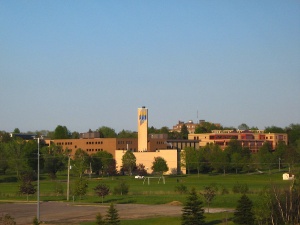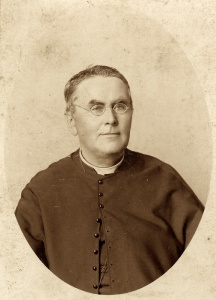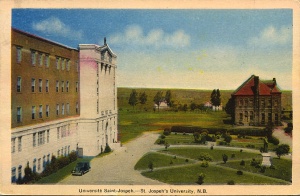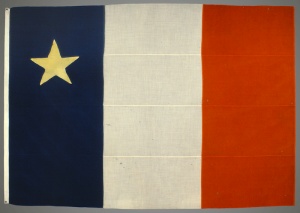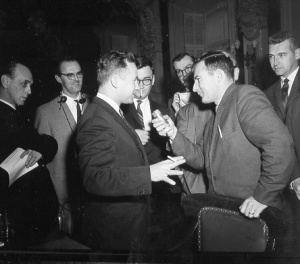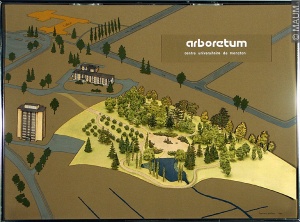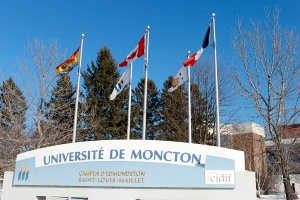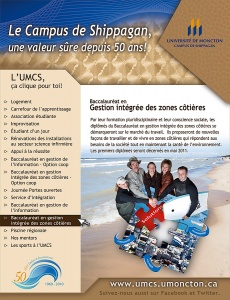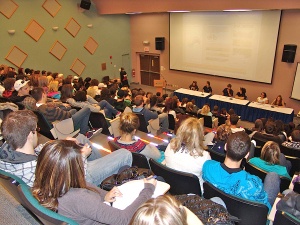Université de Moncton
par Pilote, Annie and Ratel, Jean-Luc
With over 180 programs of study and three regional campuses, Université de Moncton in New Brunswick is Canada’s largest French-language university outside Québec. Founded in 1963, the University is at the heart of the province’s Acadian and francophone heritage. It has awarded over 45,000 degrees since its establishment, contributing significantly to the community’s vitality and development. Its mission is not only educational, but cultural as well. Université de Moncton and its many affiliate organizations actively promote Acadian history, heritage, arts and knowledge, fostering Acadia’s vitality and enhancing its profile throughout the francophone world.
Article disponible en français : Université de Moncton
The Emergence of French-language University Education in New Brunswick
The idea of establishing a French-language university in New Brunswick dates back to the early 19th century. Making this dream a reality was a challenge. The opening of Collège Saint-Joseph in Memramcook in 1864 marked the true beginning of French-language higher education in New Brunswick. The college was founded in part through the efforts of Father Camille Lefebvre of the Congregation of Holy Cross. This Quebecois helped establish postsecondary schools for Catholics in the Maritime provinces. Through their university-level medical, law and teaching programs, these institutions supported the development of Acadian professionals who could work in their own communities (NOTE 1).
Collège Saint-Joseph in Memramcook was the first French-language institution to be granted university status in the province. Its provincial charter authorized it to begin awarding university degrees in 1868 (NOTE 2). This would have a domino effect in Acadian New Brunswick as other higher education institutions would subsequently open in the province’s French-speaking regions: Collège Saint-Louis in Saint-Louis-de-Kent in 1874 (closed in 1882), Collège Sacré-Cœur in Caraquet in 1899 (rebuilt in Bathurst in 1921 after a fire), Collège Saint-Louis in Edmundston in 1946, and Collège Maillet in Saint-Basile in 1963. The last two would merge in 1972 to become Collège Saint-Louis-Maillet.
Université de Moncton was officially founded in 1963 when various classical colleges were merged upon the recommendations of the Royal Commission of Inquiry into Higher Education in New Brunswick. The Commission’s report, released in 1962, not only demonstrated the need to rectify the historical underfunding of French-language universities compared with institutions like the University of New Brunswick (UNB), but also recognized the principle of creating a true French-language university in the province, given its significant French-speaking population (NOTE 3). The Commission further recommended focusing efforts on a new school that would become “the centre for professional, specialized and advanced education in the French language” (NOTE 4). This goal materialized with the creation of Université de Moncton. Due to the difficulty of providing the largely rural Acadian population with a rich and varied university education in French, the University adopted a decentralized model with three regional campuses: Moncton, Shippagan, and Edmundston.
University Education: A Tool for Cultural Development
Université de Moncton was founded during the Acadian revival. This investment in education was an expression of the Acadian community’s desire to take control of its institutions and, more generally, its socioeconomic development. The clerical and professional elite sought to preserve the Acadian identity through the construction and management of primary and secondary schools (NOTE 5). Establishing a French-language university was an extension of this intent to “create society” by building on an education system promoting an Acadian identity characterized at the time by the Catholic faith and the French language (NOTE 6).
The goal of French-language university education was to train a new generation of Acadians who were better educated and better positioned to ensure the social, cultural, and economic development of a still rather inward-looking community. The University can be seen as both the result of the modernization process undertaken in Acadian New Brunswick in the 1960s and as a major player in this movement. After decades of postsecondary education devoted mainly to training an Acadian professional elite, this new higher education institution offered a broader array of professional opportunities. It would also help redefine the identity of Acadian youth by providing students with cultural resources and a space for collective mobilization (NOTE 7).
New Brunswick in the 1960s was undergoing widespread modernization in the wake of the “Equal Opportunity” program of Louis J. Robichaud’s Liberal government. The program’s promises of justice and equality instilled new hopes in the hearts of Acadian youth, as highlighted in Herménégilde Chiasson’s 1986 film Robichaud. Indeed, the University would be the setting for student activism in 1968, when students, galvanized by a liberal ideology at odds with traditional nationalism, rose up to protest against a tuition increase. This student movement quickly grew into a francophone movement. Faced with the city of Moncton’s refusal to offer bilingual services, 2,000 people marched in the streets to the dismay of Mayor Jones, who had become a subject of scorn for francophones throughout the province. These students would become the role models for a modern, secularized Acadian identity based primarily on language (NOTE 8).
On to New Challenges
When Université de Moncton opened in 1963, all classes and services were housed in a single building. With the exception of the liberal arts programs taught at the various affiliated colleges, everything was centralized on the Moncton campus. Over the years, new faculties were created and in 1972, the University was reconfigured to clearly establish itself as a lay institution of higher education for New Brunswick francophones. During this first decade, increases in staff and government funding allowed the University to diversify its programs and services. Despite pressure to boost “productivity” and build ties with the business community (NOTE 9)—pressures common to all Canadian universities—Université de Moncton will always maintain its unique mission of serving the province’s French-speaking Acadian minority.
Though applied programs offering better economic prospects (for both graduates and the community) have been the focus since the late 1970s, Acadian studies remain an exception to this rule and a priority for the school’s development. This distinction is in some ways the University’s “signature” as evidenced today by the Institut d’études acadiennes, the Canadian Institute for Research on Linguistic Minorities, the master’s program in Acadian Studies, and the Musée acadien.
The University’s role cannot be understood without taking into account its unique mission with regard to New Brunswick’s francophone minority and the persistent inequalities in school attendance, especially at the postsecondary level, between the province’s two linguistic communities. Despite the challenges faced by Canadian universities in recent decades and the concerns aired in writings on the topic, Université de Moncton has consistently reaffirmed its key role in the development of the Acadian community. Since the institution’s founding, this “legitimate principle” has never been abandoned and continues to characterize the unique contribution the University makes to New Brunswick’s Acadian and francophone communities..
Involvement in Every Region Served
Despite the recommendations in the final report of the 2007 Commission on Post-Secondary Education in New Brunswick, the idea of closing the two regional campuses (outside of Moncton) seems to have been quickly abandoned. The strong reactions in the communities concerned illustrated the important role of the Shippagan and Edmundston campuses, which have become an integral part of the institution.
Over time, these campuses have taken on their own personalities with distinct programs of study and specialties such as integrated coastal area management at the Shippagan campus and forestry at the Edmundston campus. These two programs are indicative of how the University has taken local characteristics and needs into account in both Shippagan (along the Gulf of St. Lawrence) and Edmundston (the hub of the province’s forestry industry). Shippagan’s undergraduate program in integrated coastal area management, the only one of its kind in Canada, focuses on sustainable development of coastal resources (peat, fishing, aquaculture, forests, and agriculture), which is greatly needed in the region’s communities. Edmundston’s forestry faculty offers bachelor’s and master’s programs in forest sciences centred on the environmental, biological, socioeconomic, and technological aspects of this industry. There is also an 830 ha experimental forest near the city that is used for research and teaching and for educational and recreational purposes.
The University’s role in the regions it serves is also evident in the Centre de documentation et d’études madawaskayennes, opened on the Edmundston campus in 1978. It houses over 80 private and institutional archival collections related to the Madawaska region. The Shippagan campus boasts the Centre international d’apprentissage du français, which offers intensive courses and teacher internships in French as a second language.
The Moncton campus’ many chairs, centres, institutes, and research groups underscore the University’s unique mission and illustrate the important contribution academics make to the development of the society they live in. The Chair of Acadian Studies, for example, is doing research on metropolitan Moncton, the work of Antonine Maillet, and the media in Acadia. At the same time, the McCain Chair of Acadian Ethnology Research is working on developing Franco-Newfoundlander cultural resources and publishing core works of Acadian literature. Also of note is the Caisses Populaires Acadiennes Chair of Cooperative Management, which supports professors and students working in the field of cooperative management, and the Canada Research Chair of Intergroup Relations, which works closely with civil society institutions to help develop public policy advocating health and prevention.
Here in Canada’s only officially bilingual province, the Canadian Institute for Research on Linguistic Minorities is helping to raise awareness of the everyday realities of language minorities throughout the country, with a special emphasis on the arts, culture, identity, diversity, and vitality of these communities. The primary goal of the Institut d’études acadiennes is to support research and teaching within the University’s Acadian studies program, a mission shared by the Centre d’études acadiennes Anselme-Chiasson, home to the world’s largest public collection of archives and documentation about Acadia. Finally, the Groupe de Recherche sur les cultures en contact studies intercultural exchanges, especially within small communities and nations, and brings together researchers from different fields in multidisciplinary collaboration.
In addition to teaching and research, the Moncton campus serves the surrounding community through its Galerie d’art Louise et Reuben-Cohen. Since its founding by Father Clément Cormier in 1965, this gallery has put together a permanent collection of artwork that it continues to expand every year. It has also housed a contemporary art documentation centre since the mid-1980s. The Musée acadien de l’Université de Moncton, founded in 1886, is the oldest museum devoted to Acadia. With a collection of over 35,000 artifacts and photographs, it explores various facets of Acadian history in its permanent exhibition, and also hosts traveling exhibitions in an additional space. Examples include exhibitions on the poem Évangéline, Acadian music, and the Great Upheaval. These two facilities demonstrate the University’s desire to highlight Acadian heritage and make it accessible to all.
A Catalyst for Change
The University’s history may be short, but it is closely entwined with the Acadian “awakening” that prompted the French-speaking minority to take charge of its institutions and integrate more fully into the various spheres of New Brunswick society. Though the challenges it faces are similar in many ways to those of other universities its size, its unique mission serving Maritime francophones will always be intimately linked with its teaching, research, and community service.
Beyond its borders, the Université has also entered into agreements with twenty different countries to facilitate and expand student and researcher exchanges. From Mexico to China, from France to Morocco, these outreach initiatives go hand in hand with the involvement of New Brunswick Acadians in international organizations such as La Francophonie. Though originally dedicated to meeting the needs of its immediate community, Université de Moncton continues to fulfill its primary mission while highlighting the Acadian heritage of New Brunswick abroad and enriching it with contributions from around the world.
Annie Pilote
Associate Professor, Université Laval
Jean-Luc Ratel
Doctoral Candidate, Université Laval
Notes
1. Naomi E.S. Griffiths, “LEFEBVRE, CAMILLE,” in Dictionary of Canadian Biography Online. University of Toronto/Université Laval, 2000. Online: http://www.biographi.ca
2. Clément Cormier, L'Université de Moncton–Historique, Centre d'études acadiennes, Moncton, 1975: p. 8.
5. Annie Pilote, “L’école : un lieu d’expression de la tension démocratique,” in De Sève, M. and S. Langlois (eds.), Savoirs et responsabilités, Nota Bene, Québec, 1999: p.157-170; Greg Allain, Isabelle Mckee-Allain and Joseph Yvon Thériault, “La société acadienne : Lectures et conjonctures,” in Jean Daigle (ed.), L’Acadie des Maritimes, Chaire d’études acadiennes, Moncton, 1993: p. 341-384.
6. Louis Francisco Cimino, Ethnic Nationalism among the Acadians of New Brunswick: an Analysis of Ethnic Political Development, doctoral thesis, Durham, Duke University, 1977:
7. Allain, Mckee-Allain and Thériault, op. cit.
9. Mourad Ali-Khodja, “Réflexions sur la crise de l'institution universitaire et ses conséquences en milieu minoritaire: le cas de l'Université de Moncton en Acadie,” Égalité, no. 50, 2004, p. 51-72.
Bibliography
Ali-Khodja, Mourad, « Réflexions sur la crise de l'institution universitaire et ses conséquences en milieu minoritaire: le cas de l'Université de Moncton en Acadie »,Égalité, no 50, 2004, p. 51-72.
Allain, Greg, Isabelle Mckee-Allain et Joseph Yvon Thériault (1993), « La société acadienne: Lectures et conjonctures », in Jean Daigle (dir.), L’Acadie des Maritimes, Chaire d’études acadiennes, Moncton, p. 341-384.
Belliveau, Joël, Tradition, libéralisme et communautarisme durant les « Trente glorieuses » : Les étudiants de Moncton et l’entrée dans la modernité avancée des francophones du Nouveau-Brunswick, 1957-1969, thèse de doctorat inédite, Université de Montréal, 2008.
Cimino, Louis Francisco, Ethnic Nationalism among the Acadians of New Brunswick : an Analysis of Ethnic Political Development, thèse de doctorat, Durham, Duke University, 1977, 270 p.
Commission sur l'éducation postsecondaire au Nouveau-Brunswick, Avantage Nouveau-Brunswick : Une province cherche à accomplir sa destinée (Rapport final), Fredericton, septembre 2007, 63 p.
Cormier, Clément, L'Université de Moncton – Historique, Centre d'études acadiennes, Moncton, 1975, 404 p.
Deutsch, John, Rapport du Comité sur le financement de l'enseignement supérieur au Nouveau-Brunswick, Fredericton, 1967, 72 p.
Pilote, Annie, « L’école : un lieu d’expression de la tension démocratique », in De Sève, M. et S. Langlois (dir.), Savoirs et responsabilités, Nota Bene, Québec, 1999, p.157-170.
Thériault, Joseph Yvon, Faire société – Société civile et espaces francophones, Sudbury, Prise de parole, 2007, 384 p.
Additional DocumentsSome documents require an additional plugin to be consulted
Images
-
 Affiche pour la journ
Affiche pour la journ
ée Portes ouver... -
 Affiche pour le Bacca
Affiche pour le Bacca
lauréat en gest... -
 Avenue de l'Universit
Avenue de l'Universit
é, Moncton, 200... -
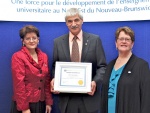 Banquet du 50e annive
Banquet du 50e annive
rsaire du campu...
-
 Billet de la Banque d
Billet de la Banque d
u Collège St.-J... -
 Collège St. Joseph, W
Collège St. Joseph, W
estmorland Co.,... -
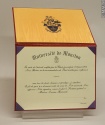 Diplôme type de l'Uni
Diplôme type de l'Uni
versité de Monc... -
 Élèves en science inf
Élèves en science inf
irmières de l'U...
-
 Fascicule des cours d
Fascicule des cours d
'été de l'Unive... -
 Journée Portes ouvert
Journée Portes ouvert
es : secteur de... -
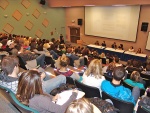 Journée Portes ouvert
Journée Portes ouvert
es : table rond... -
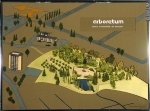 Plan de l'Arboretum,
Plan de l'Arboretum,
Université de M...
-
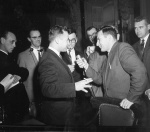 Point de presse du pr
Point de presse du pr
emier ministre ... -
 Quelques diplômés de
Quelques diplômés de
droit de l'Univ... -
 Quelques formateurs d
Quelques formateurs d
e l'Éducation p... -
 Université de Moncton
Université de Moncton
à Edmunston, 2...
-
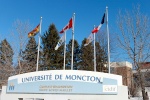 Université de Moncton
Université de Moncton
campus d'Edmun... -
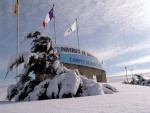 Université de Moncton
Université de Moncton
, 2006 -
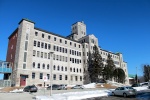 Université de Moncton
Université de Moncton
, campus d'Edmu... -
 Université Saint- Jos
Université Saint- Jos
eph, NB
-
 Université St-Joseph,
Université St-Joseph,
Nouveau-Brunsw... -
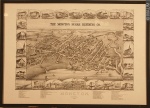 Ville de Moncton, 188
Ville de Moncton, 188
1 -
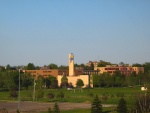 Vue d'une partie du c
Vue d'une partie du c
ampus principal...
Hyperliens
- Université de Moncton main website
- Site de l'Université de Moncton, campus d'Edmunston
- Site de l'Université de Moncton, campus de Moncton
- Site de l'Université de Moncton, campus de Shippagan

